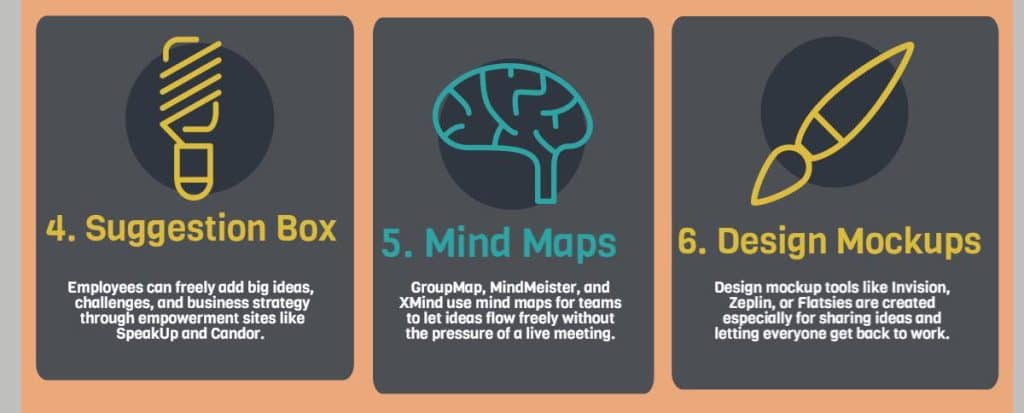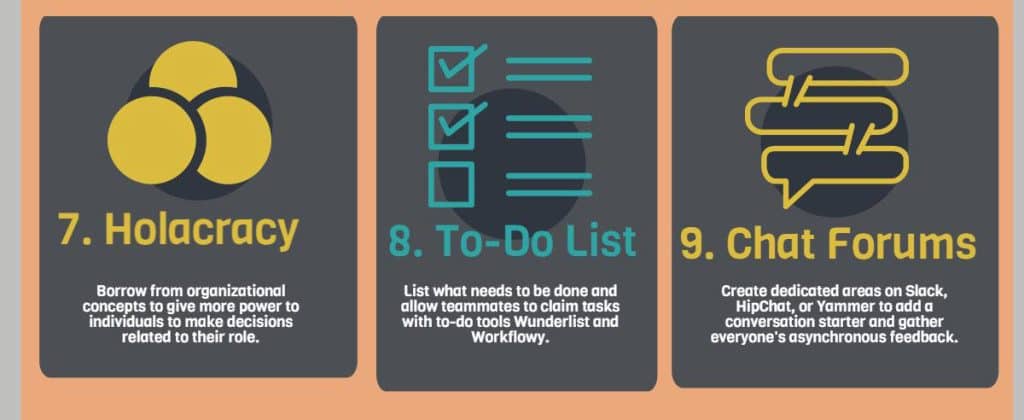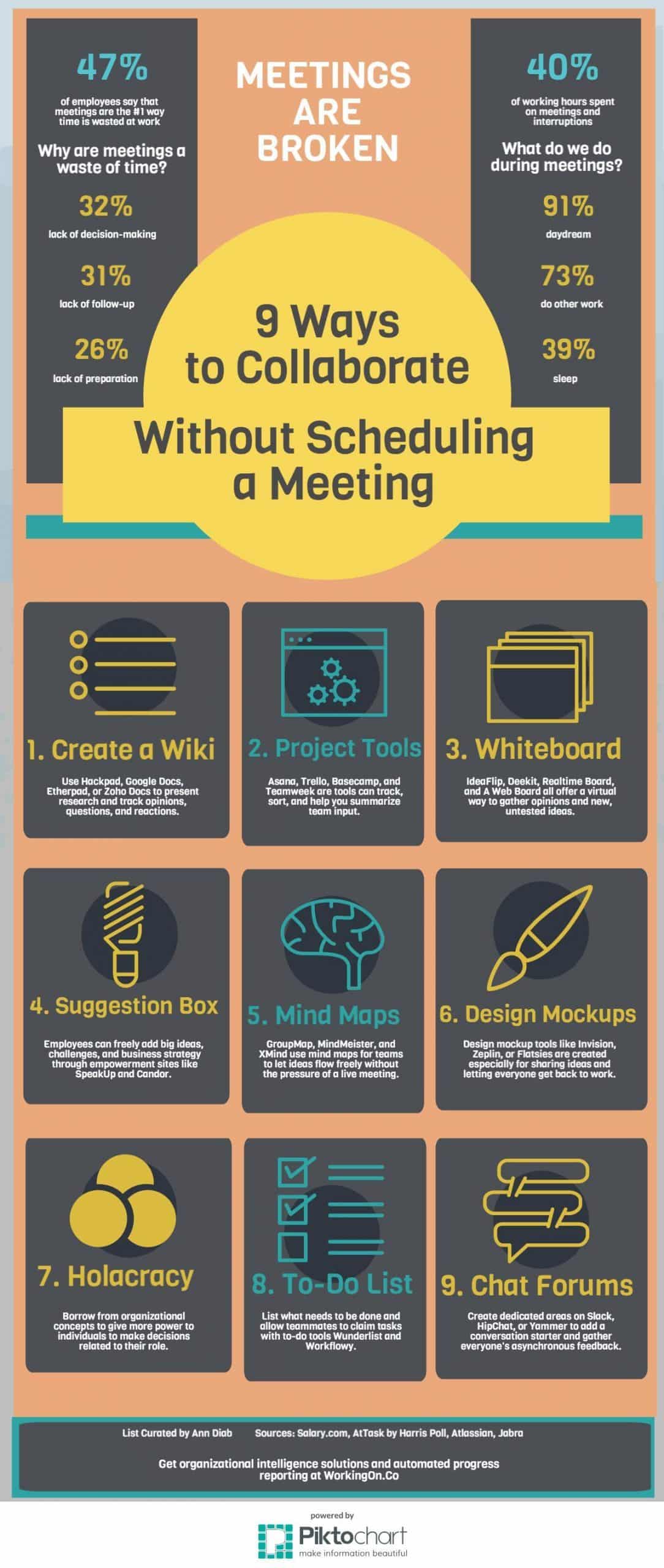“People who enjoy meetings should not be in charge of anything.” – Thomas Sowell
Despite all of the hot productivity topics and thought pieces available to us, we are still not as productive as we could actually be at work. Interruptions and distractions are all around us.
Even if no one is asking you for updates or springing requests on you, you’re probably interrupting yourself every 10 minutes to check your email or refresh your social notifications.
You’re not alone. Gallup reports that 52% of smartphone owners say they check their phone a few times per hour or more!
So, by the time you get into a creative groove on the big task you’ve set for yourself today, you get a notification for the 11 am team meeting. Oh no!

Well, maybe you can keep one window open on your laptop to keep working away while submitting some well-timed “uh-huh”s throughout the meeting.
[irp posts=”13923″ name=”The Big List of 51 Hacks to Boost Your Creativity”]
Office workers spend an average of 4 hours per week in meetings (is that all?), and half of them say that time is wasted. We’ve all figured out that meetings suck and we’ve all read the tips on how to make meetings suck less. Then why are we still having meetings, and why does it seem like almost everyone says they are a waste of time?
Piktochart offers templates for presentations, reports, posters, infographics, and more. Collaborate to create visuals for free! Get unlimited access to templates by simply creating an account.
Four ways meetings suck
1. Agendas aren’t really agendas
One of the first pieces of advice organizers employ to fix their meetings is “set an agenda.” But it seems as if no one actually knows how to set an agenda that will ensure a concise way to share information and move directly to action items and takeaways.
“The fact that most people think any written list of topics constitutes an agenda demonstrates how completely they’ve missed the point.” – Ann Latham, Uncommon Clarity
2. Attendees fall into the trap of “social loafing”
When grouped together, individuals will often reduce their efforts in order to avoid doing more work than another team member.
This might sound like a simple personality problem, but studies repeatedly find that individuals learn that their efforts as part of a group will not have as significant an impact as if they had done the work separately.
In fact, there exist multiple ways to maximize your productivity that you may not be optimizing yet!

3. Being worried about others’ opinions is a real thing
This is also scientifically proven, and also not just a matter of low self esteem.
In a neuroscience study at Emory University, Gregory Berns discovered through MRI scans that the brain activates an involuntary fear of rejection when a person prepares to state an opinion that is different from the group’s ideas. Woah.
“The brain regions associated with perception can be altered by social influences.” – Gregory Berns, Social Conformity Study
4. Makers need large blocks of time to get their work done
Folks who identify as Makers need larger blocks of time to complete their most important tasks and feel a sense of accomplishment, before allowing for a change of scenery or break in concentration.
Y Combinator cofounder and well-known software programmer Paul Graham explained this concept in an essay called Maker’s Schedule, Manager’s Schedule. According to Graham:
- Programmers and writers “generally prefer to use time in units of half a day at least”
- “A single meeting can blow a whole afternoon, by breaking it into two pieces each too small to do anything hard in”
- For Makers, a meeting isn’t simply a new task. It changes the very mode in which they are working
Maybe we’re doing collaboration wrongly
Almost all of us work in teams, and a ton of us work in open space floor plans. Every year, the number of team organization or project management tools grows, and you’ve probably got at least one shared calendar that helps the whole company know when you are available for another meeting.
Collaboration and brainstorming seem like some of the strongest tools to use when improving your product or business strategy.
But maybe we’re not really onto something. Adrian Furnham, the author of Culture Shock and noted management expert, says that “business people must be insane to use brainstorming groups.”
Wait, really? But brainstorming is what leads to an exponential number of great ideas, right?
“Talented, motivated people should be encouraged to work when their creativity or efficiency is optimum.” – Adrian Furnham, The Brainstorming Myth
Author and TED Speaker Susan Cain shares more about teamwork and why, when implemented badly, it actually gets in the way of collaboration.
In his biography, iWoz, Steve Wozniak points out how important it is for artists, inventors, and engineers, to work alone.
“I don’t believe anything really revolutionary has been invented by committee.” – Steve Wozniak, iWoz
Instead of getting everyone together for a meeting, why not get the best from your people by making conditions optimal for them? I’ve got a fancy term for you: Asynchronous collaboration.

Supporting a team of great employees means giving them the tools to do great work. Asynchronous collaboration is one of these tools. When work and opinions are shared and gathered without getting everyone in the same room or on a call at the same time, folks can find that sweet spot of solitude, which gives them a better chance at producing excellence.
The next step is to find a way to use online collaboration tools to bring all of this together.
Having access to the Internet means that our entire society benefits from shared research and information, often from innovators who share their findings after lengthy periods of solo research.
So why wouldn’t we take a cue from this process and give each other more space to work on a design project? If you need more support for the benefits of working alone, check out this research by Anders Ericsson [PDF].
When people have solitude, he concludes, they can engage in Deliberate Practice, which is the key to exceptional achievement.
“Participating in an online work group is a form of solitude all its own.” – Susan Cain, Quiet: The Power of Introverts
With Piktochart, you can collaborate with your team to create visual projects and tell compelling stories. Get started for free.
Nine ways to collaborate

1. Use a Wiki to create a collaboration document
Crowdsource information by utilizing Hackpad, Google Docs, Etherpad, or Zoho Docs. Instead of calling a meeting to review information, create an outline for the presenters to share the research that’s already been gathered.
The rest of the team can collaborate by adding their comments, questions, and reactions in-line. Create checklists in the document, or simply track access to ensure that each reviewer has had the chance to complete their analysis.
2. Utilize project management tools
Create a project, task, story, or ticket in a collaboration tool such as Asana, Trello, Basecamp, or TeamWeek. Whether it’s by moving a card from someone’s project list, or by assigning subtasks and checklists, contributions can be sorted and then summarized.
Be creative and enable these tools to meet your needs, even if it’s not the way that most folks have used it.
3. Create a virtual whiteboard
Whiteboarding joins visual storytelling with systemic processes, and it doesn’t have to be done in the same room. Thanks to technology, virtual whiteboards make asynchronous ideas come together.
Tools include A Web Whiteboard, Realtime Board, and Deekit. In addition to drawing boxes and arrows, reviewers and collaborators can add notes and discover new business ideas.

4. Utilize suggestion aggregators
Strategy and goal-setting are common meeting topics, but definitely among the type of ideas that employees often feel reluctant to share with a large group. That, and when meetings run long, the chances of bringing up new suggestions shrink.
Take advantage of suggestion aggregators such as SpeakUp and Candor to allow your team to submit ideas and concerns as they come up, rather than waiting until Thursday’s meeting. Or worse: deciding not to share at all because the meeting has already dragged into lunch time.
5. Use mindmaps
Assist your team in coming up with ideas or letting thoughts flow freely without watching the clock by equipping them with mind mapping strategies.
And then you can use mind mapping tools to allow other team members to play off those ideas. Try MindMeister, GroupMap, or XMind to test this concept online.
6. Use design mockup tools
Whose time is better served by submitting one piece of input and getting back to work? Whose input is absolutely crucial to every step of this process? These are the perfect questions to ask when you’ve got design decisions to make.
“Review mockups” seems like a great agenda item for a meeting, but it’s not a great way to succinctly gather input and move on. Identify the final decision maker, and allow that person to consider the input after the team has shared. Assign a period of time that allows the team to devote their highest concentration to this task.
InVision, Zeplin, and Flatsies all offer great ways to share design plans with reviewers and help the creators work together to make the project happen.

7. Borrow from holacracy
Completely changing your style of management is no small ordeal. But considering the valid points of many forms of leadership can allow you to arrive at the hierarchy and organization style that best fits your company.
When employees have clearly defined roles, they know when they can execute a decision and when they need input. Companies that fully deploy Holacracy often utilize Glass Frog, a web application that organizes roles and circles. You can borrow from these concepts and incorporate them into your own team wiki, or manipulate other project tools to complete similar functions.
8. Use to-do tools
“We’ve got a big project coming up, so we need to know who can help with what.” Ever heard that request at the start of a meeting? Now that’s definitely the type of meeting that should be avoided at all costs and the kind that inspires the most social loafing.
Avoid the awkward silences and the off-topic challenges. Simply lay out all of the needed logistics online, and direct team members to claim the appropriate number of subtasks. This is another type of collaboration that you can create in the project tools you already have.
Or, try out Wunderlist or Workflowy to customize and share to-do lists.
9. Create dedicated chat forums
Chat tools are amazing for transparency, culture, cohesion, and conversation. They can also be noisy and distracting.
The first rule of effective use of communication tools is notification management. Once you get that down, creating and enforcing the topics for the rooms, groups, and channels that organize communication is super important.
For instance, in Slack, you might have a Sales channel with a channel description that explains to the whole company what type of messages are expected there. Whether you’re using Slack, HipChat, or Yammer, you can add a place for specific challenges and projects to be discussed.
Set the description for this virtual meeting room, invite the appropriate collaborators, and advise them to turn off notifications for this conversation. Treat it like a moderated message board where conversation starters are submitted, and then all opinions are gathered at the end of the challenge.
Piktochart offers professional templates to create engaging presentations, reports, infographics, and more. Strengthen your internal communication by signing up for free!
What other tools or processes do you use to collaborate without actually meeting up? Let us know in the comments below!




